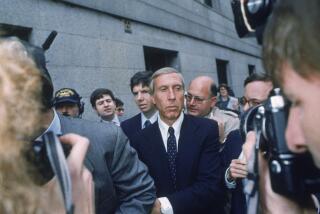Enron’s Troubles Could Spur Securities Reforms
- Share via
Ultimately, the fall of Enron Corp., the onetime rising star of the energy industry, may be remembered as a landmark in the annals of securities law and shareholder rights.
The firm’s practices are under investigation by the Securities and Exchange Commission. Enron is the focus of numerous shareholder lawsuits that seek to recover damages from the $60-billion plunge in the company’s value in the last year.
The Enron case could result in new securities laws, experts say. It also could result in massive damage awards because of the extent of stockholder losses. Shares sold at more than $84 apiece a year ago, and at $36 a month ago before the emergence of hidden losses sent the price reeling downward to current levels below $5 a share. (The stock closed Friday at $4.71 on the New York Stock Exchange.)
Significantly, two suits against Enron charge that the firm’s top executives breached their fiduciary duty of loyalty and prudence by failing to inform Enron employees of dangers to the company’s finances while those employees held Enron stock in their 401(k) retirement plans.
The firm’s troubles raise fundamental questions of what a company owes shareholders in the management and understandable disclosure of its accounts.
But Enron’s predicament also goes to the heart of the U.S. financial system, says former SEC Chairman Arthur Levitt. Enron “represents a lack of the kind of disclosure that is fundamental to maintaining confidence in U.S. public markets,” Levitt says.
Enron, technically speaking, disclosed in annual reports and proxy statements for 1999 and 2000 the existence of partnerships that in some cases “acquired debt and certain equity securities of certain Enron subsidiaries.” But it did not disclose the significance of the partnerships, nor did it consolidate their transactions in its reports to shareholders and the SEC.
Its references to the partnerships were in footnotes to financial statements, written in the arcane legal language typical of such documents. For example, disclosure of one partnership, LJM Cayman, read in part: “LJM received 6.8 million shares of Enron common stock, subject to certain restrictions and Enron received a note receivable and certain financial instruments hedging an investment held by Enron.”
Enron entered into at least 33 partnerships, attracting investments from pension funds and other investors in return for pledges of Enron stock at a guaranteed value. One partnership held 12 million Enron shares, which at one point were worth more than $1 billion.
Yet until this year, Enron treated the partnerships as insignificant to its overall business, and so they were not required to be included in its overall accounts.
By treating its partnerships as non-consolidated subsidiaries, Enron could report lower debt burdens than it actually had, thus strengthening its credit and enabling itself to grow into the largest energy trader in the world.
Enron became a pioneer of energy trading, a way of using financial techniques of trading forward commitments in natural gas and electricity to establish future prices on long-term supply contracts. As the business boomed, Enron’s revenue soared, from $20 billion in 1997 to $100 billion in 2000. Through three quarters of this year, the firm was on course to exceed $200 billion in revenue.
But in October, Enron announced that it had lost more than $600 million in the third quarter and that it needed to reduce shareholder equity by more than $1 billion due to transactions with one of its partnerships.
Then on Nov. 8, Enron restated its accounts back to 1997, acknowledging that some of its partnerships should have been included in company accounts all along. The restatement resulted in a reduction of reported profit by more than $500 million. Enron’s board of directors and auditors had ordered the restatement, the firm said.
The stock price fell further, lawsuits ensued and Enron sought refuge in a merger with Dynegy Inc. Enron’s financial position and stock price have weakened since the merger announcement Nov. 9., so the Dynegy deal may go through at a reduced price, says analyst Stanley Foster Reed, who runs MergerCentral.com, an online information service.
But the question remains of how such a large, significant company could collapse with so little advance notice.
Enron was a prominent company, not least because of Chairman Kenneth Lay’s connections to the White House as formal energy advisor to the first Bush administration and as informal advisor to the current Bush administration.
The firm had more than 20,000 employees before recent layoffs, and it had millions of investors through the holdings of pension funds such as the California Public Employees’ Retirement System, the college teachers retirement plan TIAA-CREF and major mutual funds. Yet for all its prominence, Enron’s disclosures about its business were inadequate. “Disclosure” sounds like a technical term, but it is the principle behind the laws passed in 1933 and subsequent years to regulate securities markets and protect the public.
Companies issuing stock to raise financing from public investors are required to disclose accurate and complete information about their business and to have accounts certified by independent public accounting firms. The SEC, created in 1933, could not stop a company from issuing stock, but it could make it disclose all relevant facts about risks in its business.
The laws were written in the midst of the Great Depression, which followed the 1929 stock market crash. They were designed to remedy abuses such as the case of Charles Mitchell, head of City National Bank (a predecessor firm of today’s Citgroup), who sold his own company’s shares short--that is, he bet on their price declining--just before the crash, without informing other shareholders. Before securities laws, Mitchell had no legal requirement to disclose his activities; once the laws were passed, all top managers and directors of public companies had such legal, fiduciary duty.
The Enron case probably will lead to new laws regulating investments in subsidiaries, experts say. The SEC staff has contemplated such regulations in the past but never made them law.
And the fallout from Enron could lead to tighter restrictions on firms putting their stock in employee retirement accounts. Also, it could lead to tighter regulations on statements by top managers on the condition of the business.
“This will be a case, with major issues of concealment from shareholders,” says San Francisco attorney Steven Siderman, who is preparing a class-action lawsuit against Enron and Arthur Andersen, Enron’s accounting firm.
Enron executives gave no indication of the company’s troubles as late as August, when Jeffrey Skilling, president and chief executive for only six months, abruptly resigned. In response to questions of trouble in the company, Skilling said, “There’s nothing to disclose. The company’s in great shape.”
Lay, who stepped back into the top post, told employees in August that Enron’s business was strong. “We’ve got a lot of great stuff going on and we’re not getting credit for it in the marketplace, but we will,” Lay said.
However, both Lay and Skilling had been selling Enron stock for more than a year at that point, Lay cashing out more than $140 million in stock options and Skilling more than $60 million in options.
Meanwhile, employee 401(k) accounts, heavily laden with Enron stock, were frozen this year because the firm changed account managers. Employees were stuck as the stock plummeted.
The principle behind securities laws is that management of a public company, with so many employees, pensioners and other institutions depending on it, is a public trust.
The charge in the lawsuits being filed against Enron is that the firm, its executives and directors betrayed that trust.
Everyone is entitled to a fair trial, and Enron and its executives will surely have many days in court in the months and years to come in which to defend against the charge of betrayal of shareholders and employees.
The Enron case will be a landmark.
*
James Flanigan can be reached at [email protected].
More to Read
Inside the business of entertainment
The Wide Shot brings you news, analysis and insights on everything from streaming wars to production — and what it all means for the future.
You may occasionally receive promotional content from the Los Angeles Times.










